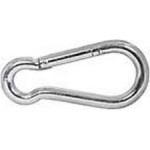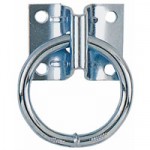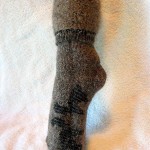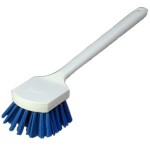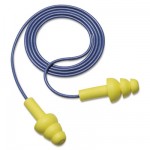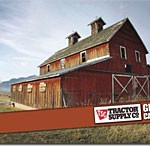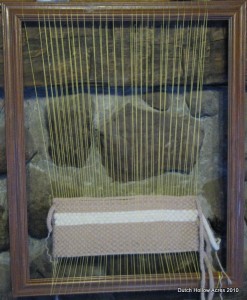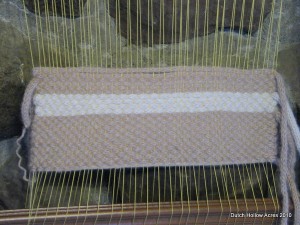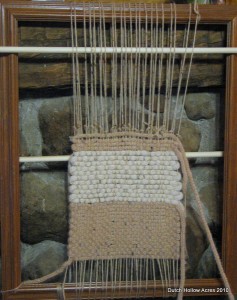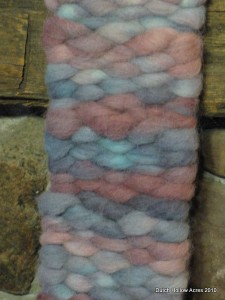Fiber Arts Friday – How To Weave On A Peg Loom

Hello Fiber Arts Friday, Crafty Friday fans and DIY Craft Linky!
As promised here is the tutorial on how to make and use a peg loom! (video at end of post)
Peg loom or peglooms are a popular fiber art in the UK but I could not find any information readily available in my internet searches on how to make or use this easy tool here in the states. So, I figured I’d make my own.
The concept of a peg loom is very simple; it’s just a board, with holes drilled in it with pegs put in those holes. Here’s the materials list I used to make my loom.
– 2×4 board (at least 3ft long if you plan on making rugs)
– (4) 7/16 dowel
– Measuring tape and pencil
– Hand saw
– Cordless drill
– 1/2 inch drill bit and a small bit just large enough for yarn to be thread through it
– Weaving material – bulky yarn, roving, fabric strips or even raw fiber
Cut your dowels down into 6” pieces (should get 36 out of 4 dowels)
On your 2×4 mark a spot in the center of the board every 1 inch, this is where you will drill holes (36 holes in all). If you’re using a different sized dowel the rule of thumb is do double the diameter of your down to get the measurement to mark for drilling.
Next start drilling where you marked. Test your depth on the first hole by drilling down a bit and then putting the dowel in so it wants to stay in the hole. Usually ½ – ¾ depth.
Next put all your dowels in the drilled holes and mark with your pencil where the dowel and the board meat. Remove the each dowel and with a small drill bit drill a tiny hole about ¼ inch above the marked line.
Your Done!
Warping your Peg Loom
First determine the width you project will be. For the scarf in the video I’m using only 3 pegs. If you’re making a rag rug or a wool rug this loom can make up to a 3 foot wide rug!
Next choose your warp material. Your warp will not show in your finished project unless you want to use it as fringe at the ends. Your warp threads will need to be double the length of your finished product plus a little extra for fringe or to be used to tuck in.
Thread each peg with your warp and place the peg in its hole.
Weaving material can be anything from raw fleece locks, roving, rag stripes or even chunky yarns. (I’ll do a tutorial on using raw fiber at a later time when I get more fluff off my alpacas)
Weaving on your Peg Loom
To start off make a slip knot and place it over the first peg. Weave in and out of all the pegs, when you get to the end come around the last peg and weave in and out the way back. Continue until your pegs are full.
When pegs are full pick up each peg and push down the weave onto the strings and replace the peg, repeat with the remaining pegs.
Wash, rinse, repeat, LOL. Yup that’s it keep on going it’s that easy.
When you get to the end tie off your last bit to the end peg.
Warp strings should now be knotted. Tie the first (3) strings together on each end and then every (2) strings in the middle. This will prevent your work from falling off the end. Do the same on your finished end.
You can choose to leave your knotted warp strings as fringe or you can sew them up into your project.
Here’s the video of the peg loom scarf from start to finish. Don’t worry I go hyper fast 12x through most of it so my 1/2 hour scarf fits in this video.
2010 Section 179 Alpaca Tax Incentive Con’t
Are you looking to get into alpacas but are still waiting for the “right time.” Well the best time to buy is at the end of the calendar year! Why? Thanks to the economic stimulus plan, the Section 179 tax incentive has been extended until 12/31/10! Which means you can purchase your alpacas now and write them off in full the first year!
No farm no problem! Check out our post on Agsting alpacas vs owning your own farm.
Want to know what your immediate return on investment will be using Section 179? Use this calculator.
We have great alpacas to start you out right.
Fiber Arts Friday – Picture Frame Looms
Welcome Back Fiber Arts Friday and Crafty Friday Folks
Sticking with my theme from last week I’ve been researching homemade looms and decided to try one of them out. I picked a simple picture frame loom to start with and though the loom is simple apparently the technique for use is not.
Picture Frame Loom Attempt 1:
I found an old frame in my basement, knocked out the glass and said goodbye to the ugly hotel art that was in there and got to work. The warp is VERY simple. Take your string/yarn and wrap the loom on the longest side. Wrap as wide as you want your end project to be and space the yarn about ¼” apart, keep tension taught and even.
Weave your fiber of choice over under all the strands. Because there’s a space in your warp thanks to the thickness of the frame one direction of weaving is very fast and the other direction is slow going having to go over/under on the way back.
Here’s my work thus far… FAIL. As you can see I started to cinch the ends too tightly and the bottom of my project is wider than the top. ERRR
Picture Frame Loom Attempt 2:
Ok, so I totally ripped apart my project and started again. This time I decided to try using some dowels to speed the process up. 1 Dowel is fed through the center of the warp to keep it open. The 2nd Dowel I put on the bottom and used loops of yarn to attach each top strand to the dowel. That way when I pulled on the dowel all the attached strands would move with it causing a nice little shed row without me having to weave over/under.
Here’s my new attempt. Still a fail in my mind but I’ve gotten better with leaving slack at the edges so they don’t taper in. I was using a fork to pack my rows and apparently I didn’t do that great of a job because they are very loose. Oh well, I’m still learning.
Top Secret Loom Project.
Ok my last loom experiment used a new loom entirely but alas I didn’t have time to document it so I’ll have to leave you wondering how I made this until another post. I’ll give you a hint though… this type of loom is often used to weave raw wool locks. For my mini test project in this photo I chose to use some pin drafted roving (available in our shop of course). I can’t wait to attempt a full scale project on this loom. I’m going to see if I can use raw alpaca, I’m not sure how well it’ll hold together since alpaca doesn’t have the memory or desire to felt quickly like wool. Don’t worry, I plan to document the dickens out of this method since it is rarely used.
Last day to enter the Alpaca Sock Giveaway – Drawing is tomorrow 11/13/10
Alpaca Sock Giveaway!
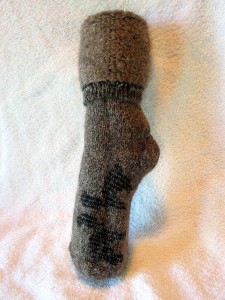 Alpaca Sock Giveaway
Alpaca Sock Giveaway
From now until 11/12/10 you can enter to win a pair of Extreme Alpaca Socks. There are 5 different ways to enter. Use one method or increase your chances by doing all 5!
Entry methods:
Like AlpacaBytes on Facebook
Like Dutch Hollow Acres on Facebook
Follow Us on Twitter
Comment on this Post! – Spam will be deleted and is not eligible
Purchase an item from our Shop
Winner will be picked on Saturday 11/13/10



